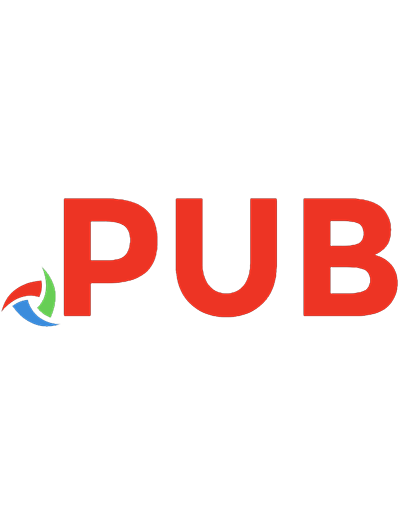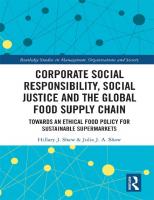Experiencing Food: Designing Sustainable and Social Practices: Proceedings of the 2nd International Conference on Food Design and Food Studies (EFOOD 2019), 28-30 November 2019, Lisbon, Portugal 0367494140, 9780367494148
Experiencing Food: Designing Sustainable and Social Practices contains papers on food, sustainability and social practic
771 284 4MB
English Pages 148 [149] Year 2020

- Author / Uploaded
- Ricardo Bonacho
- Maria José Pires
- Elsa Cristina Carona de Sousa Lamy
- Categories
- Technique
- Food Manufacturing
Table of contents :
Cover
Half Title
Title Page
Copyright Page
Table of contents
Preface
Committee members
Food design methods to inspire the new decade. Agency-centered design. Toward 2030
1 DESIGN AND CREATIVITY FOR A MORESUSTAINABLEWORLD
1.1 Humans needs to be inspired to be moresustainable
2 TO ACHIEVE THE SDGS
2.1 Education and innovation in the agri-foodsector
3 DESIGNING FOR THE NEW DECADE. THELAST 10YEARS AND THE NEXT 10YEARS
3.1 My experience at Gustolab International
4 CONCLUSIONS
REFERENCES
Designing with a fork: Lessons from past urban foodscapes for the future
1 INTRODUCTION
2 PRE-INDUSTRIAL URBAN FOODSCAPES
2.1 The location of cities
2.2 Size and distribution of pre-industrial cities
2.3 The hinterland of pre-industrial cities
2.4 Food production within pre-industrial cities
2.5 Urban form: squares, streets and buildings inpre-industrial cities
3 CONTEMPORARY URBAN FOODSCAPES
3.1 From local foodsheds to global foodsheds
3.2 Sustainable cities for a sustainable future
3.3 How urban design can take lessons from thepast for more sustainable cities
4 CONCLUSION
Feeding new alternatives: Reducing plastic in the take-away industry
1 INTRODUCTION
2 A FRAMEWORK FOR SUSTAINABILITY
2.1 Sustainable food design
2.2 The fate of disposable plastics
2.3 Understanding the system
3 CHANGING THE PARADIGM OFPACKAGING DESIGN
3.1 Understanding
3.2 Defining consumers, competition and materials
3.3 Sketching ideas
3.4 Prototyping and testing
3.5 Project proposal
4 CONCLUSION
REFERENCES
Food system photographic portraits: A necessary urban design agenda
1 INTRODUCTION
1.1 Food and the city
1.2 The food system as an urban issue
1.3 Structure, methodology and aim
2 THE SURVEY ON PORTUGUESE REGIONALARCHITECTURE (IARP)
2.1 Context, goals and methodology
2.2 A sample of a photographic portray on food &urban form in IARP
3 THE SURVEY ON THE 20TH CENTURYARCHITECTURE IN PORTUGAL (IAPXX)
3.1 Context, goals and methodology
3.2 A sample of a photographic portray on food &urban form in IAPXX
4 DISCUSSION
Gastronomic potential and pairings of new emulsions of vegetable origin
1 INTRODUCTION
1.1 Food industry and innovation
1.2 Spreads and mustards
1.3 Consumer trends and sensory evaluation
1.4 Food pairing and the online tool
2 MATERIALS AND METHODS
2.1 Samples
2.2 Gastronomic potential evaluation
2.3 Statistical analysis
3 RESULTS AND DISCUSSIONS
3.1 Gastronomic potential revealed
3.2 Foodpairing possibilities
4 CONCLUSIONS
ACKNOWLEDGEMENTS
REFERENCES
#Foodporn vintage, food depiction – from symbolic to desire
1 WHAT IS #FOODPORN?
1.1 Religious and symbolic approach
1.2 Food depiction
REFERENCES
Where interaction design meets gastronomy: Crafting increasingly playful and interactive eating experiences
1 INTRODUCTION
2 DESIGN AND GASTRONOMY
2.1 Gastronomy: experiences that transcend food
2.2 The state of play in gastronomy
2.3 The chef- and dish- centric model
3 TOWARDS AN INTERACTION DESIGNINSPIRED APPROACH TO GASTRONOMY
3.1 Activity as the ultimate particular of interactiondesign
3.2 Crafting immersion through real activity
3.3 Ambiguity as a design resource
3.4 Transformative play
3.5 The pleasures of disputation
3.6 Game-inspired affordances
4 CASE STUDY: THE MAD HATTER’SDINNER PARTY
4.1 The Magic Potion
4.2 The Cards
4.3 The Magic Forest
4.4 The Labyrinth
4.5 The Dragon
4.6 The Dragon’s Blood
4.7 The Moment of the Truth
5 CONCLUSION
ACKNOWLEDGEMENTS
REFERENCES
Sustainability on the menu: The chef’s creative process as a starting point for change in haute cuisine (and beyond)
1 INTRODUCTION
2 CREATIVITY IN HAUTE CUISINE
2.1 Understanding creativity in food and designCreativity is the ability to come up with new ideas
2.2 Mapping the chef’s creative process
2.3 Methodology
3 SUSTAINABILITY ON THE MENU
3.1 Sustainable haute cuisine?
3.2 How chefs can contribute to change: the‘mackerel campaign’ in Portugal
4 CONCLUSION
REFERENCES
‘Squid Inc’: Designing transformative food experiences
1 INTRODUCTION
2 FOOD EDUCATION
2.1 The need for a holistic and transformative foodeducation
2.2 Discourses on food literacy
2.3 Food literacy through transformative learningand creativity
4 DESIGNING MEANINGFUL FOODEXPERIENCES
4.1 Food design as a methodology for foodeducation
4.2 Multisensory experience design
5 METHOD
6 RESULTS AND DISCUSSION
6.1 Skills and knowledge
6.2 Transformative experiences
6.3 From ‘medium’ to larger food system complexit
7 CONCLUSION
REFERENCES
Beyond product-market fit: Human centered design for social sustainability
1 A NOTE ON BEGINNINGS
1.1 The sustainability of 3 pillars thinking
1.2 Human centered design
1.3 New product development
1.4 Product-market fit
2 THE FILET-O-FISH PARABLE
2.1 JFK: America’s first Catholic president
2.2 (No) fish on Fridays
2.3 Prices and participation may vary
2.4 See store for details
3 PUTTING IT ALL TOGETHER
4 CONCLUSION (BRING IT ON HOME)
REFERENCES
Designing menus to shape consumers’ perception of traditional gastronomy: Does it work for the Portuguese Alentejo cuisine?
1 INTRODUCTION
2 MATERIALS AND METHODS
4 DISCUSSION
5 CONCLUSIONS
ACKNOWLEDGEMENTS
REFERENCES
Seaweeds: An ingredient for a novel approach for artisanal dairy products
1 INTRODUCTION
2 MATERIALS AND METHODS
2.1 Seaweeds
2.2 Cheese manufacture
2.3 Butter manufacture
2.4 Butter packaging
2.5 Focus group discussion
3 RESULTS AND DISCUSSION
4 CONCLUSIONS
ACKNOWLEDGEMENTS
REFERENCES
Introduction of seaweeds in desserts: The design of a sea lettuce ice cream
1 INTRODUCTION
1.1 Seaweeds
1.2 Phycogastronomy
1.3 Ice cream
2 SEA LETTUCE FLAVOR PROFILE
2.1 Seaweed sensory analysis
2.2 GC–MS analysis
2.3 Sea lettuce vs. green tea
2.4 Food pairing
3 SEAWEED ICE CREAM DESIGN
3.1 Ice cream formulation and techniques
3.2 Ice cream preparation tests
3.4 Application of the ice cream in a highgastronomy dessert
3.5 Health claims
4 CONCLUSIONS
ACKNOWLEDGMENTS
REFERENCES
From industry to the table: The tableware sector in Portugal
1 INTRODUCTION
2 DISCUSSION
2.1 Historical review
2.2 Regulamentation in Portuguese ceramicindustry
2.3 CP2S – ceramics, heritage and sustainableproducts – from teaching to industry
2.4 Cases of study
3 CONCLUSIONS
REFERENCES
WEB
Designing grassroots food recovery circuits in urban Romania
1 INTRODUCTION
1.1 A bottom-up approach to food saving
1.2 Food waste under the anthropological lens
1.3 The social value of food surplus
2 THE CASE OF THE VANISHING PRODUCE
2.1 Creating a food saving model from scratch
3 “BEST BEFORE”: A RACE AGAINST THECOMMERCIAL CLOCK
3.1 Creating a food saving model from scratch
4 CONCLUSIONS
REFERENCES
Food Design Dates: Design-under-pressure activities in a cross-cultural and multidisciplinary online collaboration
1 INTRODUCTION
1.1 Background
1.2 Co-creation and collaboration
1.3 Multidisciplinary and experiential learning
1.4 Design-under-pressure for onlinemultidisciplinary collaboration
2 A STUDY FOR MULTIDISCIPLINARYPEDAGOGY IN CROSS-CULTURALENVIRONMENTS
2.1 Introduction
2.2 Content
2.3 Method
2.4 Research questions
2.5 Technicalities
3 FINDINGS: DESIGN OF CROSS-CULTURALFOOD DESIGN
4 DISCUSSION
REFERENCES
Development of dishes free from the main food allergens – a case study
1 INTRODUCTION
2 MATERIALS AND METHODS
2.1 Materials
2.2 Identification of the main food allergens and itsreplacers
2.3 Preparation of the raspberry soup
2.4 Preparation of the meringue
2.5 Preparation of the ice cream
2.6 Preparation of the almond scented caramel
2.7 Focus group and sensory analysis
3 RESULTS AND DISCUSSIONS
4 CONCLUSION
REFERENCES
Integrating and innovating food design and sociology – healthy eating
1 INTRODUCTION
2 UNDERSTANDING THE SOCIAL
2.1 Healthy meals in schools
2.2 The obesity epidemic
2.3 Foodscape as a bridging conceptualization?
3 DISCUSSION
3.1 The great potential for further integration
4 CONCLUSION
REFERENCES
Design, short food supply chain and conscious consumption in Rio de Janeiro
1 FOOD FOR THOUGHT
2 METHODOLOGY
2.1 Immersion
2.1.1 Preliminary immersion: desk and exploratoryresearch
3 RESULTS
4 DISCUSSION
5 CONCLUSIONS
REFERENCES
From Asia to Portugal – fermentation, probiotics and waste management in restaurants
1 INTRODUCTION
1.1 The focus
1.2 Fermentation
1.3 Asia
1.4 The probiotic world
2 FERMENTATION AND SUSTAINABILITY
2.1 WRSF/SRDF
3 EXPERIMENTATION AND RESULTS
3.1 Mead
4 CONCLUSION
REFERENCES
The experience of the natural world in a moment of fine dining – interwoven approaches to sustainability
1 INTRODUCTION
2 METHODOLOGY
3 THE PROCESS
4 THE MENU
5 THE EXPERIENCES
5.1 Momentum: from forest to the plate – part I(Sintra, June 2019)
5.2 Momentum: from forest to the plate – part IIand III (Lagoa and São Brás de Alportel,November 2019)
5.3 Momentum: from forest to the plate – part IV(Lisbon, November 2019)
6 RESULTS AND CONCLUSIONS
Floating dish, a sustainable, interactive and fine dining concept
1 INTRODUCTION
2 MATERIALS AND METHODS
2.1 Food stimulus
2.2 Container
2.3 Procedure
2.4 Design process
3 DISCUSSION
4 CONCLUSION
ACKNOWLEDGEMENT
REFERENCES
Author index


![Experiencing Food: Designing Dialogues: Proceedings of the 1st International Conference on Food Design and Food Studies (EFOOD 2017), October 19-21, 2017, Lisbon, Portugal [First edition]
9781351271936, 1351271938, 9781351271943, 1351271946, 9781351271950, 1351271954, 978-1-351-27196-7, 1351271962, 978-1-138-57538-7](https://dokumen.pub/img/200x200/experiencing-food-designing-dialogues-proceedings-of-the-1st-international-conference-on-food-design-and-food-studies-efood-2017-october-19-21-2017-lisbon-portugal-first-edition-9781351271936-1351271938-9781351271943-1351271946-9781351271950-1351271954-978-1-351-27196-7-1351271962-978-1-138-57538-7.jpg)



![ICSDEMS 2019: Proceedings of the International Conference on Sustainable Design, Engineering, Management and Sciences [1st ed.]
9789811537646, 9789811537653](https://dokumen.pub/img/200x200/icsdems-2019-proceedings-of-the-international-conference-on-sustainable-design-engineering-management-and-sciences-1st-ed-9789811537646-9789811537653.jpg)


